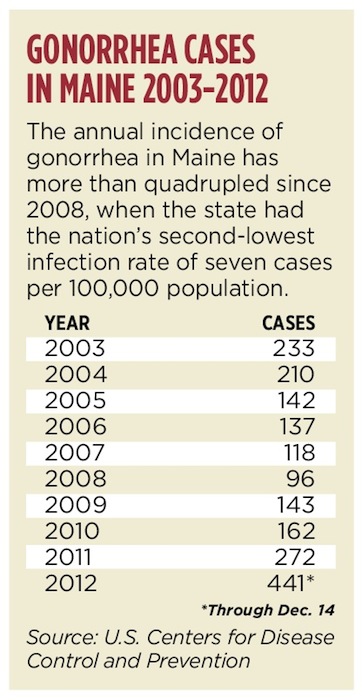The annual incidence of gonorrhea in Maine has more than quadrupled since 2008, when the state had the nation’s second-lowest infection rate, according to the Maine Center for Disease Control and Prevention.
The increase – from 98 cases five years ago to 441 through Dec. 14 of this year – has state health officials scrambling to launch a public education campaign targeting Mainers in their 20s, who account for more than half of all reported cases in 2012.
Officials also are urging health care providers to screen all sexually active Mainers who may have been lax in protecting themselves against venereal diseases, said Dr. Stephen Sears, the state epidemiologist.
“They ought to be testing for this routinely,” Sears said Thursday. “The increased infection in Maine is concerning and it’s mirroring a national trend.”
Maine’s infection rate is growing faster than national and regional rates, however, at a time when the bacterial disease is becoming resistant to some antibiotic treatments.
The U.S. Centers for Disease Control and Prevention updated its treatment guidelines in August, recommending several alternatives to oral cephalosporins that are proving ineffective in many cases, Sears said.
While antibiotic-resistant gonorrhea hasn’t cropped up much in Maine, Sears said, health care providers are being advised to follow the new treatment guidelines because the U.S. population is increasingly mobile.
The Maine CDC will review this year’s gonorrhea cases in the coming weeks to look for patterns and trends among various racial, gender and age groups, Sears said.
“We actually don’t know all the reasons why we’re seeing an increase,” he said. “All of the messaging around safe sex in recent years may not be followed as much.”
Maine’s total of reported cases rose from 162 in 2010 to 272 in 2011, a 68 percent increase, pushing the infection rate from 12 cases to 20 cases per 100,000 population, according to the federal CDC.
So far this year, Maine’s gonorrhea cases have spiked 62 percent, to 441 cases, and driven the infection rate to an estimated 33 cases per 100,000 population, based on Maine CDC figures. That’s nearly five times the 2008 infection rate of seven cases per 100,000 population.
In comparison, gonorrhea cases reported nationally rose from 309,341 cases in 2010 to 321,849 cases in 2011, according to the federal CDC, up 4 percent.
The increase pushed the national infection rate up 4 percent, from 100 cases to 104 cases per 100,000 population.
However, the national infection rate has decreased 14 percent overall since 2008, when it was 121 cases per 100,000 population.
Just over 300,000 gonorrhea cases had been reported nationally through Dec. 17 this year, according to the federal CDC.
The agency estimates that more than 700,000 Americans get new gonorrhea infections each year, but less than half are reported to health officials.
Southern states, as in previous years, had the highest infection rates in 2011 (135 cases per 100,000 population), followed by the Midwest (111 cases), Northeast (86 cases) and West (62 cases).
However, the Northeast experienced the greatest increase in infection rates (11 percent) from 2010 to 2011, followed by the West (6.5 percent), the Midwest (2.7 percent) and the South (2.1 percent).
By 2011, Maine’s gonorrhea infection rate of 20 cases per 100,000 population ranked 44th in the nation.
States with lower infection rates were Idaho, Utah, New Hampshire, Montana, Wyoming and Vermont, which reported only 48 cases last year and had an infection rate of just under eight cases per 100,000 population.
Of the 441 gonorrhea cases reported in Maine so far this year, 240 were among people in their 20s, according to the Maine CDC.
More than 60 percent of the 20-somethings were women, who risk infertility, ectopic pregnancy and chronic pelvic pain if the disease goes untreated, Sears said.
The highest number of cases was reported this year in Androscoggin (189) and Cumberland (115) counties, where a public education campaign will be targeted.
More women contracted the disease in Androscoggin County and more men got it in Cumberland County, Sears said.
Gonorrhea is transmitted by sexual contact. A baby can contract the disease from its mother during childbirth.
The highest infection rates are reported among teenagers, young adults and African Americans, according to the federal CDC.
Symptoms for men include burning during urination, penile discharge and painful or swollen testicles.
Women may have similar burning and discharge, plus vaginal bleeding between periods, but many experience no signs of infection.
If left untreated, gonorrhea can spread to the blood or joints and become life-threatening.
Studies have shown that having untreated gonorrhea also increases a person’s risk of getting or transmitting HIV, the virus that causes AIDS, according to the federal CDC.
Health officials recommend using latex condoms, getting tested, limiting partners and having sex only with people who have been tested and cleared.
Staff Writer Kelley Bouchard can be contacted at 791-6328 or at:
kbouchard@pressherald.com
Send questions/comments to the editors.



Success. Please wait for the page to reload. If the page does not reload within 5 seconds, please refresh the page.
Enter your email and password to access comments.
Hi, to comment on stories you must . This profile is in addition to your subscription and website login.
Already have a commenting profile? .
Invalid username/password.
Please check your email to confirm and complete your registration.
Only subscribers are eligible to post comments. Please subscribe or login first for digital access. Here’s why.
Use the form below to reset your password. When you've submitted your account email, we will send an email with a reset code.